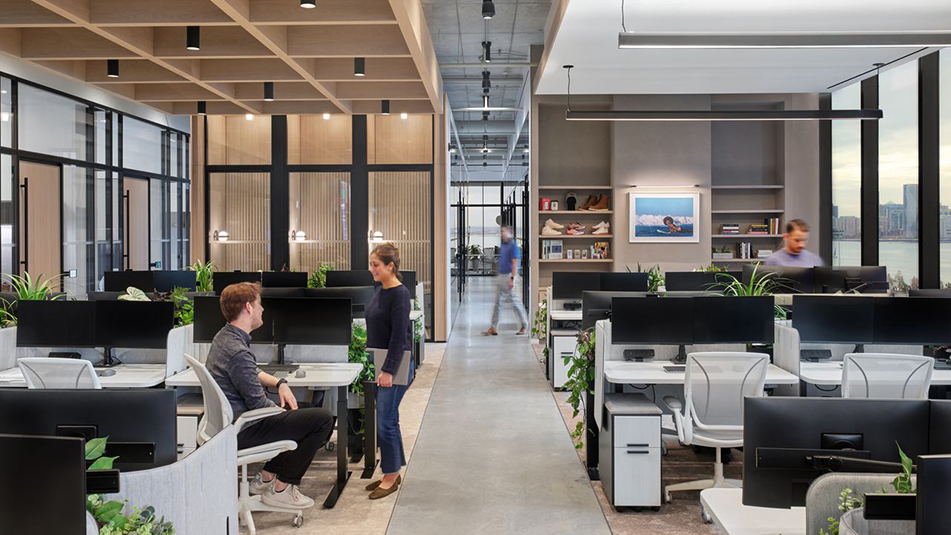“Hybrid” Work is not binary. Learn the many ways companies are solving for employee flexibility and learn how you can align the best approach for your people in three straightforward steps to move into the future with confidence.
The variety of experiences and unanswered questions continue to consume our work and workplace conversations. Seeking resolve, we hear them frequently: “Will it stick? Should we launch a mandate? And is remote work helping or hindering our culture?” As practitioners of change, we are paying attention to the signals of transformation in this ever-evolving picture of workplace and future(s) of work.
Evident on a client call recently, a noticeably unique perspective was shared. It felt like a lightning bolt of conviction, in a dense field of fog.
A global professional service firm recently affirmed that “our current work patterns will serve as our new baseline to design for.” As practitioners of workplace strategy and change management, this felt profound. Ostensibly new, to hear an organization so confidently accept the current behavior as practical data to inform the real estate portfolio, rather than classify the present as a temporary condition.
Uncannily timed, Zoom transported me to the other side of the hybrid spectrum, to reveal a completely different company’s perspective. Also confident, this client had measured a decline in innovation and productivity, and layered urgency to their heightened talent churn. With this negative experience, they naturally associate current flexibility (a.k.a. “hybrid") with poor performance; thus, are ready to regress back to pre-pandemic “norms.”
And this is the tale of two modern truths, where “hybrid” is working for some companies and seemingly inhibiting others. Yet while these two very recent, very real examples show the binary (all in or all out) opinions of hybrid, it is imperative to repeat that hybrid is a wide spectrum of employee flexibility, policies and mobility patterns. One policy may not fit all, and the patterns appear to be as seasonal as the pandemic itself.
So, if hybrid isn’t binary, what are the most common types of hybrid work arrangements?
![]()
How are organizations determining what is best for their offices? Clients are wondering…
- Is one policy going to work for everyone? If not, Is it fair to offer variety?
- Should we mandate, or let managers decide?
- How will we know this is working for us?
- Will people quit if we change the policy now, again?
As a team of strategists focusing on the future of work, clients consult Cresa looking for answers to these questions, and more. Cresa Workplace Solutions leads clients through tangible steps forward to unpack the hybrid lexicon.
We know how to design the appropriate hybrid policy for an organization, team, or individual. The approach must be informed with solid data to gain buy-in and consensus with stakeholders. And once decided, have a game plan that will stick. Here are a few steps to get started on your journey.
1. Start with Data
a. Quantify the current behavior and understand the contrast to pre-pandemic levels. Measure your current mobility patterns: Many organizations are using a blend of data sources, from badge swipes to conference room bookings, occupancy sensors like 4SITE, and wifi pings.
i. Workplace utilization sensors, such as 4 SITE help an organization understand exactly how your workforce is using their space.
ii. By comparing the current condition to the pre-pandemic experience, you may reveal varying levels of impact. By launching an Impact Analysis, such as the framework from PROSCI, you may find certain roles or departments maybe more change saturated than others.
2. Classify Mobility Personas
a. Workplace programs have radically shifted, from 1-to-1 assigned desks to a diaspora of work point choices. Your footprint can easily be calculated by analyzing the roles and departments within your organization. A mobility persona is informed from two very necessary quantitative “lenses” to understand:
i. 1) Mobility Patterns. How often is an employee working at the office, traveling, remotely working at a client site, coworking, or working from home, etc.?
ii. 2) Activity Patterns. How frequently is an employee interacting with others to complete their tasks?
b. Compliment your mobility profiles with a role assessment. Leaders should articulate whether a job is appropriate to do without proximity to real-time colleagues or adjacency to equipment on site. While a recent report from McKinsey proclaimed that “about 20% to 25% of the workforces in advanced economies could work from home between three and five days a week without loss of productivity,” this lacks an understanding of other critical factors for an organization’s holistic success. Organizations know that remote work has placed more pressure on succession plans, promotion criteria, quality of mentorship and innovation… not to mention the impact on organizational culture and belonging.
Once your team has gathered the quantitative data, be sure to gather your employee voice. We all know that the approach to hybrid (and many other decisions) isn’t just determined from a spreadsheet, so it is critical to add a qualitative sentiment to the mix. As reported frequently, employees’ personal situations are highly influential to their level of hybrid policy adoption.
3. Gather Employee Voice
a. By collecting perspectives of employees, you will reveal insight to the barriers people may be facing, and opportunities to enhance the workplace experience to better serve as a magnet for the in-office vibrancy people desire (and maybe miss most).
i. 1) Surveys may be the most common method. While we are noticing survey fatigue, an employee will never tire of feeling heard and seen. Done right, and inspiring action, surveys can be a meaningful key to your hybrid solution.
ii. 2) Prototype the hybrid concept with inclusion. It has been proven that cross-disciplinary collaboration is most successful in sustaining change. Ask yourself: has our hybrid analysis strategically included diverse perspectives? Different ages, tenures and roles, genders, sexual identities and abilities will add the necessary voice to your process for long-lasting, empathy-based work practices. – Did you Know? People of color are most at risk if companies regress to a 5-day workweek mandate.
Wherever you stand on “the right way” for your organization, the methods outlined here can serve as the tangible steps forward to unpack the hybrid lexicon. If you are looking for help to design a hybrid policy for your organization, team, or individual, reach out to Cresa Workplace Solutions to kick start your journey!
Know what’s right for what’s next.
Cresa Workplace Solutions


